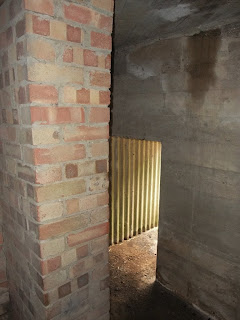A week in East Yorkshire visiting family last week - so had a quick look at a few pillboxes on the Eastern Command Line in west Suffolk on the way up. These included a shell proof infantry pillbox - looks like a large type 22 but is probably another design from CRE, Colchester possibly CRE1113 (M Osborne). Embrasures are standard bren gun types and it has a low entrance, protected by a separate blast wall. This particular example could be found at Lackford.
At Icklingam, defending a bridge across the river Lark, can be found a type 28a and another CRE1113 type infantry pillbox. The Type 28a has had the embrasure narrowed indicating it has been modified for the 6 pounder anti-tank gun instead of the 2 pounder.
Continuing north, just into the Norfolk border, stopped off at Three Holes Bridge to look at another type 28a.
Over the next few posts, the blog will be temp. renamed WW2 Defences - E Yorkshire as I post on sites visited up there!!
Image 1 & 2: Infantry pillbox, poss. to design CRE1113, LackfordImage 3: Blast wall
Image 4: Low entrance
Image 5: Bren embrasures
Image 6: Type 28a, Icklingham
Image 7: Infantry pillbox, Lackford
Image 8 and 9: Type 28a, Three Holes Bridge, Norfolk
Image 10: Embrasure
Image 11: View of bridge from embrasure, the slots in the floor for positioning the carriage of the two pounder anti-tank gun can be clearly seen.
Image 12: Bren embrasure in the infantry chamber, type 28a.












Comments
Post a Comment